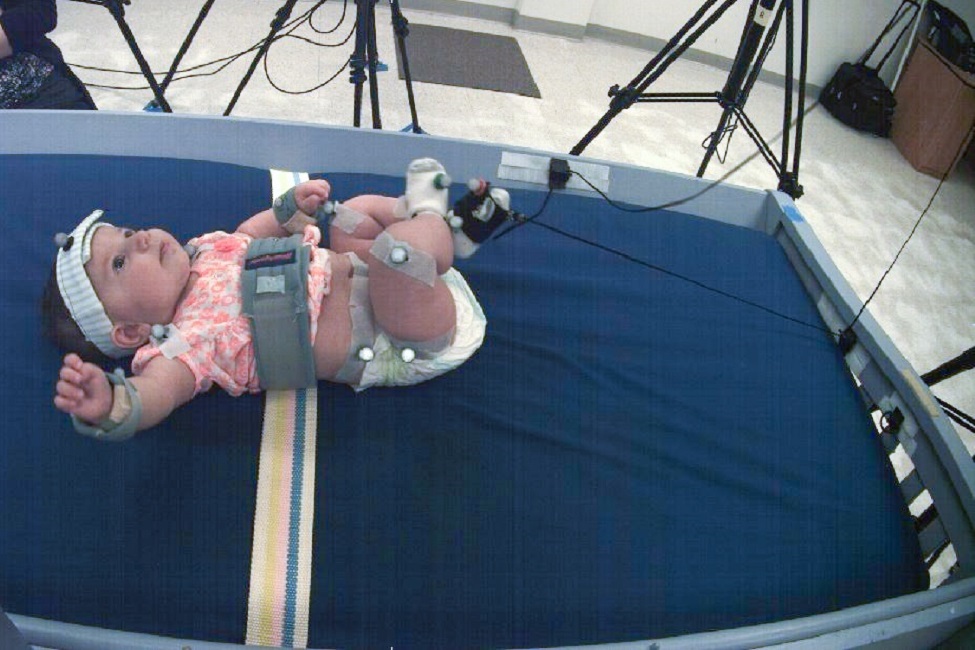Eureka! Groundbreaking Study Uncovers Origin of ‘Conscious Awareness’

When an infant’s foot is tethered to the mobile, each foot movement causes the mobile to move. Positive feedback amplifies and highlights the cause-and-effect relationship between infant and mobile motion.
Living things act with purpose. But where does purpose come from? How do humans make sense of their relation to the world and realize their ability to effect change? These fundamental questions of agency – acting with purpose – have perplexed some of the greatest minds in history including Sir Isaac Newton, Charles Darwin, Erwin Schrödinger and Niels Bohr.
A Florida Atlantic University study reveals groundbreaking insight into the origins of agency using an unusual and largely untapped source – human babies. Since goal-directed action appears in the first months of human life, the FAU research team used young infants as a test field to understand how spontaneous movement transforms into purposeful action.
For the study, infants began the experiment as disconnected observers. However, when researchers tethered one of the infants’ feet to a crib-mounted baby mobile, infants discovered they could make the mobile move. To catch this moment of realization like lightning in a bottle, researchers measured infant and mobile movement in 3D space using cutting-edge motion capture technology to uncover dynamic and coordinative features marking the “birth of agency.”
Findings, published in the Proceedings of the National Academy of Sciences, provide a solution to this age-old conundrum. Analysis and dynamical modeling of experiments on human infants suggest that agency emerges from the coupled relation between the organism (baby) and the environment (mobile). But how exactly does this happen?
When an infant’s foot is tethered to the mobile, each foot movement causes the mobile to move. It was thought that the more the mobile moves, the more the infant is stimulated to move, producing yet more mobile motion.
“Positive feedback amplifies and highlights the cause-and-effect relationship between infant and mobile motion,” said J.A. Scott Kelso, Ph.D., senior author and Glenwood and Martha Creech Eminent Scholar in Science at the Center for Complex Systems and Brain Sciences within FAU’s Charles E. Schmidt College of Science. “At some critical level of coordination, the infant recognizes its causal powers and transitions from spontaneous to intentional behavior. This aha! moment is marked by an abrupt increase in infant movement rate.”
Aliza Sloan, Ph.D., lead author and a postdoctoral research scientist in FAU’s Center for Complex Systems and Brain Sciences, developed a quantitative “aha!” detector to search for abrupt increases in infant movement rate related to sudden infant discovery.
Sloan’s technique demonstrated that the “birth” of agency can be quantified as a “eureka-like,” pattern-changing phase transition within a dynamical system that spans the baby, the brain, and the environment. The system switches from a less correlated state to a state where both movements of the mobile and the tethered limb are highly coordinated as the infant discovers its functional connection to the mobile.
Although the basic design of the experiment has been used in developmental research since the late 1960s, related research traditionally focused solely on infant activity, treating infant and environment as separate entities. In the 50 years of formal baby-mobile experiments, the FAU study is the first to directly measure the motion of the mobile and to use coordinative analysis to provide quantified observations of the emergence of human agency.
The new approach used in this study frames agency as an emergent property from the functional coupling of organism and environment. Researchers took a deep dive into the baby-mobile interaction through the eyes of Coordination Dynamics – Kelso and colleagues’ theory of how complex living things are coordinated (from cells to society) and how function and order emerge.
Although it was expected that infants would discover their control over the mobile through their coordinated action with the mobile, patterns of infant pausing were striking.
“Our findings demonstrate that it’s not just the infants’ active movements that matter,” said Nancy Jones, Ph.D., co-author, professor in FAU’s Department of Psychology and director of the FAU WAVES Lab.
A complete coordinative analysis of baby motion, mobile motion and their interaction, found that the emergence of agency is a punctuated self-organizing process, with meaning found both in movement and stillness.
“The babies in our study have revealed something really profound: that there is action in the midst of inaction, and inaction in the midst of action. Both provide meaningful information to the infant exploring the world and its place in it,” said Kelso. “The coordination dynamics of movement and stillness jointly constitute the unity of the baby’s conscious awareness – that they can make things happen in the world. Intentionally.”
The FAU study also revealed that infants navigate functional coupling with the mobile in different ways. Distinct clusters in the timing and degree of bursts of infant activity were detected, suggesting that behavioral phenotypes (observable characteristics) of agentive discovery exist – and that dynamics provide a means to identify them. This novel phenotyping method may be useful for preventive care and early treatment of infants at risk.
The study was conducted in the Human Brain and Behavior Lab within the FAU Center for Complex Systems and Brain Sciences.
This research was supported by the FAU Foundation and by National Institute of Mental Health (MH-080838) of the National Institutes of Health.
-FAU-
Tags: students | faculty and staff | science | research